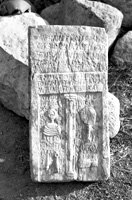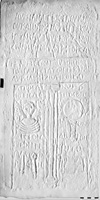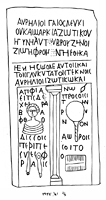 MAMA XI 141 (Pentapolis)
MAMA XI 141 (Pentapolis) 
Funerary doorstone of Aurelius Gaius and family
- Type of monument:
- Funerary doorstone.
- Location:
- Karasandıklı (Pentapolis): said to derive from the höyük. In a house opposite the hamam.
- Description:
- Rectangular slab of purple-veined Dokimeian marble. Recessed panel in the lower half of the slab representing a door, with central astragal in relief with simple capital (similar to Waelkens 1986: 196-7, nos. 486-7) and base. On the left door, in relief, a female bust above, spindle and distaff below; on the right door, in relief, mirror above, comb below.
- Dimensions:
- Ht. 0.53; W. 0.26; Th. 0.075-0.090; letters 0.012-0.030.
- Record:
- Photos; squeeze; drawing; MB notebook copy (1955/41).
- Publication:
- None.
- Date:
- Third century AD.
Αὐρήλιοι Γάϊος Λευκί-
ου καὶ Μαρκία Ζωτικοῦ
ἡ γυνὴ αὐτοῦ Βρουζηνοί
ζ{ι}ῶν φρον[ῶ]ν Η̣Ε̣Θ̣ΗΚΑ
5Η̣Ε̣Ν̣Η̣Ε̣Σ̣Τ̣ΟΝ ἑαυτοῖς καὶ
τοῖς γλυκυτάτοις τέκνοις
Αὐρηλίοις Ζωτικῷ καὶ
Ἀπφιανῷ hed.
εἴ τις δὲ προσοίσι
10χεῖρα τὴν
βαρύ-
φθονον,
δισσοῖς ἀώροις
περιπέσοιτο
15συν̣φο-
ραῖς
Aurelius Gaius, son of Lucius, and Aurelia Marcia, daughter of Zotikos, his wife, citizens of Brouzos, while still living and in their right minds... (set this up) for themselves and for their sweetest children Aurelius Zotikos and Aurelius Apphianos; and if anyone lays a hand with heavy envy (on this tomb), may he fall victim to twofold untimely misfortunes.






This monument is a simplified version of a doorstone, on which only the central astragal of the door is represented, with objects depicted in relief to left and right on the ‘doors’. The inscription provides the second epigraphic attestation of the ethnic Βρουζηνοί, thereby confirming the location of the city of Brouzos at Karasandıklı (cf. MAMA XI 136 (1955/38)). Lines 4-5 are extremely difficult to read, and it is not at all clear what the mason intended here. The sense would require a verb for ‘to set up’ in the third person plural, and a noun meaning ‘funerary monument’ in the accusative.
The curse formulae in lines 9-16 are well attested in northern Phrygia (Strubbe 1997: Appendix 1, 285-8); for a similar formula in the vicinity of Brouzos, compare Ramsay, Phrygia II 702, no. 636 (Ürküt), ὃς ἂν κακουργέσι τοῦτο, τοιούταις περιπέσοιτο συμφοραῖς. The violator of the tomb is here threatened with ἄωροι συμφοραί, the premature death of his children (Robert, OMS V 709-10, 715-23). The ‘doubling’ of the curse (line 13, δισσοῖς ἀώροις) appears to be unattested elsewhere; compare, however, MAMA X 47 (πολλῶν ἀώρων περιπέσοιτο συνφορῶν); MAMA X 105 (where read πολλο⟨ῖ⟩ς ἀώρο⟨ι⟩ς περιπέσοιτο συνφοραῖς); MAMA X 235 (πάσαις ἀώροις περιπέσοιτο συνφοραῖς); for similar examples from Kotiaion and Eumeneia, see Robert, OMS V 717.